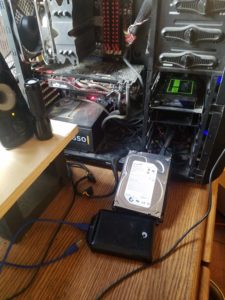Good Morning from my Robotics Lab! This is Shadow_8472, and Today, I am bringing an underwhelming tale of setting up my “toy” computer. Let’s get started.
I re-scrambled the Ram between most/all of the computers under my care this week. The Linux Mint gift now has all the RAM it came with and the RAM that was originally from the Ubuntu MATE MineCraft Server. I pulled the alleged faulty RAM from the old Asus machine out of my main tower and reclaimed my own sticks. The original Asus RAM was split between itself and the Server after it was all given a BIOS level check.
Long story short, I am tired of doing about everything except shuffling sticks of RAM like a deck of cards. The amount of force required to install the things is a little disturbing when the components around the base are caving in a little more than expected. My RAM is staying where it is for now, and all the sticks appear to work.
I wanted to do just a little bit more, so I started going about installing straight Ubuntu on the old machine to turn it into my “toy” computer despite its random crashes. I have in mind practicing what I think to be dual booting with this machine, so I disconnected the old HDD and it’s RAID SSD “memory bubble.” (Please don’t ask me how that’s supposed to work. I know of about three RAID configurations, and none of them match this setup. I just know that RAID is when more than one storage device is operating in parallel to provide extra speed or redundancy, usually with matched, HDD drives.) I pulled the brand new SSD from my own tower and hooked it up instead of the old setup.
I grabbed my green USB stick with Mint on it and decided to use it for any OS install needs in the future. I put what I thought was the latest version of Ubuntu on it, restoring it to its full 8GB while doing so from when I first put Mint on it to repair the “corrupt” HDD. I connected the target computer to my secondary monitor. I booted it and… nothing. The screen wouldn’t even turn on to access its internal settings when I connected both VGA and DVI to it. It turns out the RAM in the Asus tower was in the wrong pair of slots; RAM slots are paired, and one pair is to be filled first, and I had filled in the 3rd and 4th slots by mistake.
I moved the sticks to the appropriate slots and tried again. I made it to the BIOS where I managed to convince it to boot to the Linux Install Stick. I tried to tell it to install, but it claimed there wasn’t enough space (8. something MB and there were only 8). That didn’t sound right. That’s the size of the USB stick… I ended up making my way to the live environment desktop and was confronted with Unity.
Unity? That desktop was canceled. What’s it doing on the latest… I didn’t have the latest version. What happened? The bootable USB program from the tutorial, Rufus, did request/demand I let it download a couple of extra files just because I was trying to set up a newer version of Linux than the one it seemed to come with… I poked around on the Ubuntu download site I got the ISO from, and found the latest version unavailable, and had instead gotten the latest LTS version. Long Term Support was a term I learned quickly. It turns out the actual latest version was blocked due to security concerns with the all three common CPU architectures affected. I decided to put the project off a week and see if a new build comes through.
In the meantime, my Final Question: If you use Linux, what desktop do you use?


 At this point, I went into various fuzzily related details to create suspense, such as how I couldn’t find my other SATA cable or how I didn’t have the correct mounting for my case for this HDD. I yanked the unformatted SSD and connected the HDD and let it rest just outside the case. (The picture is from just now, not then.) Anyway, at one point, the drive was putting its weight on the power cable, so I started turning it over. My father cringed as I slowly rotated the box to avoid too strong of a gyroscopic effect on the spinning disks. He told me that Hard drives used to be sensitive to the orientation they were in when they were first formatted: they must not have had as good motor control for the read heads. While this is an aging HDD, it isn’t 90’s technology, the latest example cited as not being up to being turned on end.
At this point, I went into various fuzzily related details to create suspense, such as how I couldn’t find my other SATA cable or how I didn’t have the correct mounting for my case for this HDD. I yanked the unformatted SSD and connected the HDD and let it rest just outside the case. (The picture is from just now, not then.) Anyway, at one point, the drive was putting its weight on the power cable, so I started turning it over. My father cringed as I slowly rotated the box to avoid too strong of a gyroscopic effect on the spinning disks. He told me that Hard drives used to be sensitive to the orientation they were in when they were first formatted: they must not have had as good motor control for the read heads. While this is an aging HDD, it isn’t 90’s technology, the latest example cited as not being up to being turned on end.